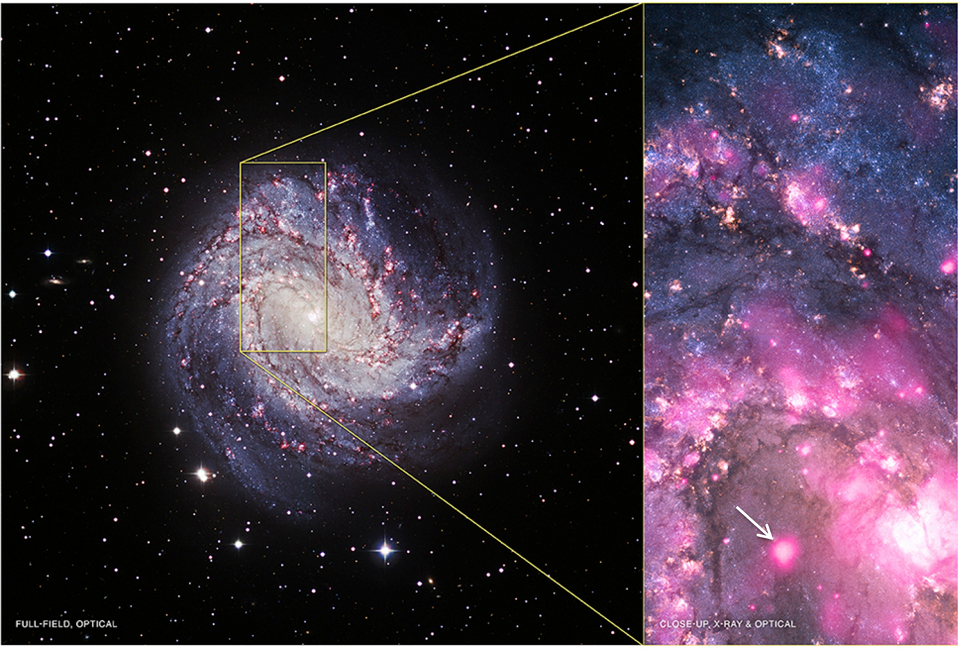
 Credit: Left, Optical: ESO/VLT; Right, composite:
NASA/CXC/Curtin University/R.Soria et al.,
Optical: NASA/STScI/Middlebury College/F.Winkler et al.
Credit: Left, Optical: ESO/VLT; Right, composite:
NASA/CXC/Curtin University/R.Soria et al.,
Optical: NASA/STScI/Middlebury College/F.Winkler et al.
A Black Hole Too Big?
The mass ranges of normal stars, white dwarf
stars, and neutron
stars are pretty well constrained by modern astrophysics. Not so the mass
range of black
holes, those mysterious singularites that lie both within and outside of our
Universe. Black holes which form from stars start out with masses of a few times
the mass of our Sun. There are also supermassive black holes, like Sgr A*, the one that lurks at
the center of our Milky Way. The relation of these "stellar mass" and
"supermassive" black holes is a matter of conjecture: do stellar mass black
holes evolve into supermassive black holes by swallowing enormous quantities of
stars and gas? Or are they formed by completely separate mechanisms? Astronomers
have been searching for some time for "intermediate-mass" black holes with
masses of hundreds or thousands of solar massers, much larger than stellar mass
black holes but much smaller than the supermassive variety. Perhaps such
intermediate mass black holes represent a transitional stage between "stellar"
and "super" mass. These intermediate-mass black holes are hard to find, however.
Maybe the best evidence of the existence of these objects are the so-called "ultra-luminous
X-ray sources". The sources are believed to be accreting gas (and maybe even
whole stars) at a prodigious rate, and as a result have X-ray luminosities that
are orders of magnitude higher than typical stellar mass black hole systems, but
orders of magnitude lower than accreting supermassive black holes. The image
above shows an unusual ULX in the galaxy M83, detected by the Chandra X-ray Observatory. An optical
image of M83 is shown on the left, while a composite X-ray/optical image is
shown on the right. The X-ray emission is shown on the right image in pink, and
the source marked by the arrow is a peculiar ULX which brightened by over a
factor of 3000 between August 2009 and December 2010. Why it brightened is a
mystery. There are also substantial puzzles about how this object could have
formed. It may be an ancient black hole left over from the days when M83 was
very young. Some researchers think that this strange source could even be a
stellar mass black hole, despite its extreme X-ray behavior. It will be of
intense interest to follow future developments of this strange object.
Published: May 7, 2012
<
HEA Dictionary ● Archive
● Search HEAPOW
● Other Languages
● HEAPOW on Facebook
● Download all Images
● Education ● HEAD
>

Each week the HEASARC
brings you new, exciting and beautiful images from X-ray and Gamma ray
astronomy. Check back each week and be sure to check out the HEAPOW archive!
Page Author: Dr. Michael F. Corcoran
Last modified May 6, 2012


